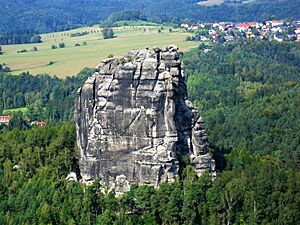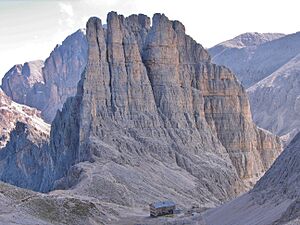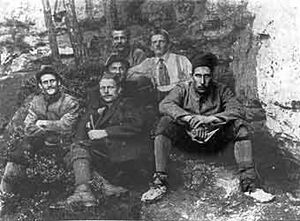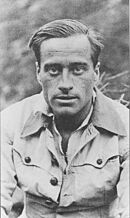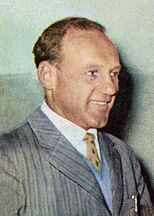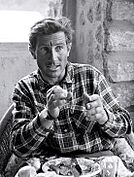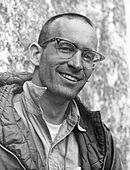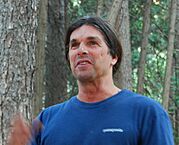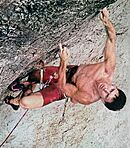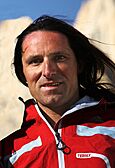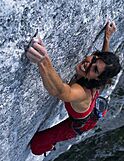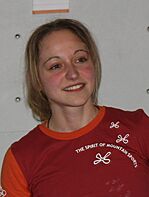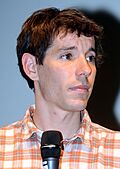History of rock climbing facts for kids

In the history of rock climbing, the three main sub-disciplines—bouldering, single-pitch climbing, and big wall (and multi-pitch) climbing—can trace their origins to late 19th-century Europe. Bouldering started in Fontainebleau, and was advanced by Pierre Allain in the 1930s, and John Gill in the 1950s. Big wall climbing started in the Dolomites, and was spread across the Alps in the 1930s by climbers such as Emilio Comici and Riccardo Cassin, and in the 1950s by Walter Bonatti, before reaching Yosemite where it was led in the 1950s to 1970s by climbers such as Royal Robbins. Single-pitch climbing started pre-1900 in both the Lake District and in Saxony, and by the late-1970s had spread widely with climbers such as Ron Fawcett (Britain), Bernd Arnold (Germany), Patrick Berhault (France), Ron Kauk and John Bachar (USA).
As a free solo exercise with no artificial aid or climbing protection, bouldering remained largely consistent since its origins. Single-pitch climbing generally stopped using artificial aid in the early 20th-century, led by Paul Preuss, so-called "free climbing". Free climbing of Big Walls started before World War I, and was advanced by Emil Solleder in the 20s, Batista Vinatzer in the 30s, and Mathias Rebitsch in the late-40s. Climbing protection was needed for single-pitch and big-wall free climbing, and was inserted into the route while climbing; this is now called "traditional climbing". By the 1980s, French pioneers like Patrick Edlinger wanted to climb rock faces in Buoux and Verdon that had few cracks in which to insert traditional climbing protection. Controversially, they pre-drilled bolts from above on rappel, using battery powered drills, into potential new routes for protection (but not as artificial aid); this became known as "sport climbing". It led to a dramatic increase in climbing standards, grades, and tools (e.g. artificial climbing walls and campus boards), the development of competition climbing (initially dominated in the 1990s by French climbers such as François Legrand), and the "professional" rock climber.
By the end of the 20th-century, the hardest sport climbs were often combinations of bouldering-moves, and some of the best challenges lay in free climbing extreme big walls; this led to greater cross-over amongst the three sub-disciplines. Leading climbers such as Wolfgang Güllich, Jerry Moffatt, Alexander Huber, Fred Nicole, Chris Sharma, Adam Ondra, and Tommy Caldwell set records in several of these disciplines. Güllich and Huber also made ever-bolder single-pitch free solo climbs, while Sharma pushed standards in deep-water soloing; Alex Honnold's big wall free soloing was turned into the Oscar-winning film, Free Solo. In 2016, the IOC announced that competition climbing would be a medal sport in the 2020 Summer Olympics.
Female rock climbing developed later in the 20th-century but by the 1980s, climbers such as Lynn Hill and Catherine Destivelle were closing the gap to the standard of routes being climbed by the leading men. By the 21st-century, Josune Bereziartu, Angela Eiter and Ashima Shiraishi, had closed the gap to the highest sport and boulder climbing grades achieved by men to within one/two notches; Beth Rodden fully closed the gap for traditional climbing grades in 2008 and Janja Garnbret became the most successful competition climber in history with 42 IFSC world cup golds.
Contents
Origins
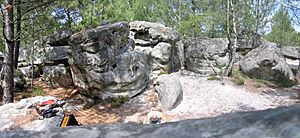
There are early documented examples of people "rock climbing" to achieve various objectives. The Le Quart Livre records that in 1492, ordered by his king, Antoine de Ville used castle siege tactics to ascend Mont Aiguille, a 300-meter rock tower, near Grenoble, France. In 1695, Martin Martin described the traditional practice of fowling by climbing with the use of ropes in the Hebrides of Scotland, especially on St Kilda.
The first ascent of Mont Blanc in 1786, started mountaineering's "modern era"; however it would take another century until the fixed anchors of rock climbing appeared, including pitons, bolts, and rappel slings. By the early 19th-century, "alpine rock climbing" was developing as a pastime; the tools of the alpine shepherd guides (early mountain guides), the alpenstock and woodcutter's axe (later combined as the ice axe).
Although the action of rock climbing had become a component of 19th-century victorian era Alpine mountaineering, a sport of rock climbing (i.e. climbing short rock routes as a recreational activity without any summit objective), originated in the last quarter of the 19th-century, and in four European locations: the Saxon Switzerland climbing region in Germany, the Lake District and Peak District in England, the Dolomites in Italy, and in the forest of Fontainebleau in France.
- The solo first ascent of Napes Needle in the Lake District, England, by Walter Parry Haskett Smith in June 1886 is widely considered to be the start of the sport of rock climbing in the UK. In 1897, O. G. Jones climbed Kern Knotts Crack at grade VS. By the early 20th-century, groups of 60 would gather at the Wastwater Hotel in the Lake District during vacations.
- The birth of climbing in Saxon Switzerland for nothing but sporting motivation is credited to gymnasts from nearby Bad Schandau who used ladders and other aid equipment to ascend the Falkenstein in 1864. Ten years later in 1874, O. E. Ufer and H. Frick free climbed the rock pinnacle "Mönch" with a similar motivation, consciously avoiding the use of aid equipment. Inspired by late 19th-century pioneers such as Oscar Schuster on Falkenstein, by 1903 there were 500 climbers in the Saxon Switzerland climbing region, including the well-known team of Rudolf Fehrmann and American Oliver Perry-Smith; their 1906 ascent of Teufelsturm at grade VIIb, set new standards of difficulty. By the 1930s, there were 200 climbing clubs in the area.
- The 1887 solo first ascent of the Vajolet Towers by the 17-year-old Munich high school student Georg Winkler, encouraged the acceptance and development of the sport in the Dolomites, and in particular opened up the era of big wall climbing on the huge rock faces of the Dolomites, which spread over the wider Alps including the important centre of Chamonix in France.
- By 1897, members of the French Club alpin français began to gather amongst the boulders of Fontainebleau to practice their rock climbing skills that they would use in the Alpine season; the boulders were shorter than the large walls being attempted in the Lake District, Saxon Switzerland or the Dolomites, but this led to the development of more advanced bouldering skills.
19th century
- 1848: Sebastian Abratzky, a local chimney sweep, enters the hill-top Königstein Fortress by climbing a chimney in the sandstone plateau to avoid the entrance fee; this is now considered the first free climb in the Saxon Switzerland climbing region, and is today a climbing route called Abratzkykamin IV (ca 5.4).
- 1857: John Ball, future president of the British Alpine Club, makes an early first ascent of Monte Pelmo, in the Dolomites.
- 1859–1869: Paul Grohmann makes numerous first ascents of rocky spires in the Dolomites, such as Tofana di Mezzo, Sorapiss, Cristallo and Langkofel.
- 1864: Gustav Tröger, Ernst Fischer, J. Wähnert and H. Frenzel, aid climb Turnerweg on Falkenstein, formally starting the sport in Saxon Switzerland.
- 1869 : John Muir, the naturalist and climber, makes an onsight free solo of Cathedral Peak in Tuolumne Meadows, Yosemite.
- 1874: Otto Ewald Ufer and H. Frick make the first first free ascent (no aid) of Mönch, in the Saxon Switzerland climbing region.
- 1875 : George Anderson climbs Half Dome in Yosemite, using drilled eye bolts for holds, and a fixed rope to return to his high point each day.
- 1876: Donald McDonald, a crofter from the Isle of Lewis climbs Handa, the first recorded climb for leisure in Britain.
- 1876: Jean Charlet-Straton invents the basic body rappel in the French Alps; its most useful form, the dülfersitz, is invented in 1910 by Hans Dülfer.
- 1881: Benedikt Venetz leads Albert Mummery and Alex Burgener on the first ascent of the Aiguille du Grépon, Chamonix, 10-pitches, and the famous 40-foot Fissure Mummery "Mummery Crack", the 5.6 crux, is maybe first-ever grade HS 4b.
- 1881: Michael Innerkofler and Hans Innerkofler ascend the Kleine Zinne in the Cima Piccola, (Tre Cime di Lavaredo), Sexten Dolomites, at 5.5 (4b).
- 1886 : June, W. P. Haskett Smith free soloed the 70-foot Napes Needle (V Diff), in the Lake District of England; this is considered the "birth" of the sport in the UK.
- 1887 : Georg Winkler, aged 17, free soloed the Vajolet Towers (5.5, 7-pitches), initiating the sport in the Dolomites, and the use of hemp-soled sailor's boots.
- 1892 : Oscar Eckenstein, early bouldering advocate, runs a competition, with cash prizes, among the natives while on an expedition to the Karakoram Mountains.
- 1892: Steel carabiners appear in the Saxon Switzerland climbing region; they can hold static body weight but are not reliably strong for dynamic leader falls.
- 1893: Lily Bristow is the first-ever female to summit the difficult Aiguille du Grepon, in Chamonix, France.
- 1893 : Devils Tower is aid climbed by ranchers William Rogers and Willard Ripley; after 6 weeks they summit on the Fourth of July.
- 1897: O. G. Jones leads, after top rope, Kern Knotts Crack at VS 4c on the Great Gable in England; potentially the first 5.7 (5a).
1900s
- 1900: (approximately) : Oscar Eckenstein demonstrates the concept of modern balance climbing on his eponymous bouldering route in Llanberis Pass, Wales.
- 1900 : Tita Piaz free soloed onsight Piaz Route on Punta Emma, Catinaccio, in the Dolomites, Italy, at 5.7 (7-pitches).
- 1900 : Heinrich Pfannel, Thomas Maischberger, and Franz Zimmer do the first-ever alpine first free ascent on the Southwest Face of Dent du Géant, in Chamonix, France, bypassing all spikes, ropes, and ladders.
- 1901 : Michele Bettaga, Beatrice Tomasson, Artolo Zagonel make the first ascent of the South Face of Marmolada, Dolomites, Italy in a day; first big wall climb (5.5, using 4 pitons for anchors on 24-pitches).
- 1906 : Oliver Perry-Smith, W. Hünig, Rudolf Fehrmann climb Perrykante on Teufelsturm, in the Saxon Switzerland climbing region; 90-feet, Sax VIIb; world's first-ever grade 5b (5.8) route.
- 1908 : Tita Piaz, J. Klammer, R. Schietzold, F Schroffenegger, make the first ascent of the West Face of Totenkirchl, Austria, UIAA Grade V (5.7 with a tension traverse) 19 pitches.
- 1909 : (approximately) Felt-soled rock climbing shoes are introduced.
1910s
- 1910 : Hans Fiechtl replaces the attached ring on pitons with an eye in the body of the piton, a design still used to this day.
- 1910 : Max Matthäus, Oliver Perry-Smith, and H. Wagner ascend the Großer Falknerturm on Matthäusriß, in the Saxon Switzerland climbing region, Sax VIIb, maybe the first 5c (5.9).
- 1910 : Max Matthäus leads Südriss on Kreuzturm, in the Saxon Switzerland climbing region, Sax VIIc, and hardest short climb for a decade, the first-ever 6a/a+ 5.10a/b .
- 1910 : Angelo Dibona, G. Mayer, M. Mayer, A. Dimai, L. Rizzi climb the 2,500-foot North Face of Cima Una, in the Dolomites, UIAA V+ (5.8).
- 1910 : Franz Schroffenegger and Franz Wenter climb the 450-metre Northwest Face of Delago Tower, and the 500-metre North Face of Croda di Re Laurino, in the Dolomites. UIAA Grade VI− (5.9−).
- 1911 : Paul Preuss free soloed the first ascent of the 900-foot East Face of Campanile Basso, in the Italian Dolomites, 5.7 (5a) on friable rock.
- 1911 : September, Paul Preuss, starts the Mauerhakenstreit (piton dispute) and advocates for a transition to free climbing; in a series of essays and articles in the German Alpine Journal, he defines "artificial aid" and proposes 6 rules of free climbing including the important rule 4: "The piton is an emergency aid and not the basis of a system of mountaineering".
- 1912 : Angelo Dibona, Luigi Rizzi, and brothers Guido and Max Mayer, climb the South Face of the Meije, in the Massif des Écrins, France.
- 1913 : Hans Dülfer free soloed, onsight, the 250-metre Dülferriss on the Fleischbank, in Austria, at UIAA VI− (5.9−) (6-pitches).
- 1913 : Hans Dülfer and Willi von Redwitz, climb the 700-metre West Face Direct, on Totenkirchl, in Austria, at UIAA V+ with two rope traverses (5.8 X), in 8 hours (23-pitches, longest rock climb to date).
- 1913 : Hans Dülfer, with only 3 pitons, leads the West Face Cima Grande, in the Dolomites, at 5.8 X (8-pitches); he invents a 5-step grading system, the rope tension traverse, and dülfersitz rappelling.
- 1913 : Rudolf Fehrmann publishes the second edition of Der Bergsteiger in der Sächsischen Schweiz (The Climber in Saxon Switzerland), which includes the first binding rules for climbing in the area to protect the soft sandstone rock. These include that only natural holds of the rock are allowed for climbing. These rules for free climbing are still in use and haven't changed significantly.
- 1914 : Siegfried Herford and companions, climb, using shoulder stands, the Flake Pitch on the Central Buttress of Scafell (5.8 A0, 5.9 today), Britain's hardest climb at the time (3-pitches).
- 1916 : Ivar Berg free soloed the 60-foot Cave Arête Indirect at Laddow Rocks, Derbyshire, England, at E1 5a (5.9+), it was the first E1.
- 1918 : Emanuel Strubich climbs, unprotected, Westkante at the Wilder Kopf, in the Saxon Switzerland climbing region, at Sax VIIIa, the world's first-ever 6a+ (5.10b), (2-pitches).
1920s
- 1921 : Oswald Kunis leads the unprotected Kuniskante on Rauschentorwächter, in the Saxon Switzerland climbing region. Sax VIIIa/VIIIb, the world's first-ever 6a+/b 5.10b/c .
- 1921 :Otto Herzog and Gustav Haber climb the 1,000-foot Ha-He Dihedral UIAA VI+ (5.9+) at Dreizinkenspitze, in Austria, in 2 days of climbing; would not be repeated until the 1950s.
- 1922 : Hans Rost leads, with 2 protection rings, the run-out on Rostkante, on Hauptwiesenstein, in the Saxon Switzerland climbing region. Sax VIIIb, the world's first-ever 6b (5.10c).
- 1922 : Paul Illmer and party ascend the unprotected Illmerweg on Falkenstein, Sax VIIc or 5.10a (6a), in the Saxon Switzerland climbing region; famous overhang known as "the mailbox".
- 1923 : Willo Welzenbach, adding to Dülfer's five grades, creates the Roman Numeral European rating system for rock climbs (Grades I to VI); this system eventually became UIAA grading.
- 1924 : Felix Simon and Roland Rossi climb the 850-metre North Face of Monte Pelmo, in the Dolomites, Italy, at UIAA V+, placing 11 pitons.
- 1925 : July 28, Fritz Wiessner, Roland Rossi climb Southeast Face of Fleischbank, Austria, at VI+/5.10a, 11 difficult pitches including 4 free pitches at Grade VI, a tension traverse pitch, and an aid pitch over a roof.
- 1925 : August 1, Emil Solleder and Fritz Wiessner climb the 750-metre North Face of Furchetta, Dolomites, a 20-pitch route and two pitches of UIAA VI (5.9) near the top.
- 1925 : August 7, Gustav Lettenbauer and Emil Solleder climb the 1,200-metre NW Face of Civetta, Dolomites in a day, UIAA VI− (5.9), 44-pitches, 15 pitons; world's hardest big wall climb.
- 1925 : Albert Ellingwood and a party of three climb the 2,000-foot Northeast Buttress (or the Ellingwood Ledges) on the Crestone Needle (14,197 feet), in Colorado, USA, at grade 5.7 (5a).
- 1927 : Laurent Grivel designs and sells the first rock drill and climbing expansion bolt.
- 1927 : Joe Stettner and brother, Paul, apply European techniques in the USA on their ascent of the 9-pitch Stettner Ledges (5.7) on the East Face of Long's Peak.
- 1927 : Fred Pigott experiments with slinging natural chockstones, and later machine nuts, for protection at Clogwyn Du'r Arddu on Snowdon, and led to the modern climbing nut.
- 1929 : Luigi Micheluzzi, Demitrio Christomannos, Roberto Perathoner make, in 2 days and placing only 6 pitons, the first ascent of the South Pillar of Marmolada, 5.9+, 600-meters, Dolomites.
- 1929 : Miriam Underhill and Alice Damesme make the first "manless" ascent of the Aiguille du Grépon, in Chamonix, France.
1930s
- 1930 : Jack Longland leads, onsight, Javelin Blade at Hollytree Wall, Idwal, at E1 5b (5.10a X) with forty-foot runout at the crux.
- 1931 : Emilio Comici invents the aid ladder, solid belay anchors, taglining, and hanging bivouacs; tools that changed big wall climbing. He used them all on his 3-day, 57-pitch, 1500-metre climb of the Northwest Face of the Civetta, in the Dolomites, mostly free (5.9+ with 3 aid sections, only 35 pitons).
- 1931 : Robert L. M. Underhill and Miriam Underhill (Miriam E. O'Brien), Early climbing couples; Robert introduced European climbing techniques in an article in the 1931 Bulletin of the Sierra Club.
- 1932 : Batista Vinatzer and Giuani Rifesser climb Furchetta North Face route, Dolomites, adding a dangerous, 5-pitch direct finish, UIAA VII− (5.10b/c X), only 5 new protection pitons.
- 1933 : Emilio Comici, Giuseppi Dimai and Angelo Dimai climb, in 3 days, the 1,700-foot North Face Dimai Route of Cima Grande, in the Dolomites, at 5.9 and 3 aid pitches; becomes the world's most overhanging big wall climbing route.
- 1933 : Batista Vinatzer and Vincenzo Peristi climb the North Face of Monte Stevia, in the Dolomites, UIAA VII− (5.10c) (6-pitches).
- 1934 : Pierre Allain champions bouldering at Fontainebleau; climbs L'Angle Allain, 5C .
- 1934 : Dick Leonard, Jules Eichorn and Bestor Robinson made the first ascent of the Eichorn Pinnacle, at Cathedral Peak in the Sierra Nevada.
- 1934 : Raffaele Carlesso, Bartolo Sandri climb, in 2 days, the 750-metre South Face of Torre Trieste, Dolomites, UIAA VIII-, maybe the world's first-ever 6c+ (5.11b/c) but it is doubted that the crux was done totally free (35-pitches).
- 1935 : Riccardo Cassin, Vittorio Ratti climb the 700-metre North Face of Cima Ovest, in the Dolomites, takes 3 days and 60 pitons, 5.9 and 3 aid sections. Most committing big wall climbing to date.
- 1935 : Fritz Wiessner and Roger Whitney, using only 1 protection piton, climb Vector, on Ragged Mountain, Connecticut, rated 5.8+ R, likely 5.9, the hardest pitch in the US for a decade.
- 1935 : Pierre Allain, added a protective rubber rand to the side of a tennis shoe as a climbing shoe; later, in 1947, with Edmond Bourdonneau (EB), he markets a stiffer, flat-soled edging shoe, the "PA".
- 1936 : Batista Vinatzer and Ettore Castiglioni free climb, in two days, a 29-pitch route on the Marmolada, Dolomites, UIAA VII− (5.10c). Hardest long, totally free climb in the world.
- 1937 : Vitale Bramani develops and sells the first leather boots with "lug-soled rubber" (called tank-tread) for rock climbing, mountaineering, and hiking; called "Vibram soles".
- 1937 : Emilio Comici re-climbs the North Face Dimai Route route on the Cima Grande alone, with some gear but no rope, mostly free-solo (5.9), but pulling on some pitons, in three and a half hours.
- 1938 : Riccardo Cassin, Gino Esposito, Ugo Tizzoni ascend, in 3 days, the classic, alpine, 3,500-foot Walker Spur of the Grandes Jorasses "...perhaps the finest in existence" Gaston Rébuffat.
- 1939 : David Brower and the rest of his Berkeley crew use four bolts for protection in the process of ascending Ship Rock in New Mexico.
1940s
- 1940s : World War II leads to the development of inexpensive, army-surplus pitons, carabiners and the newly invented nylon rope, making leader falls significantly safer.
- 1945 : Chris Preston, after a top rope, leads, with no protection, the two pitches of Suicide Wall, in Ogwen, Wales, at E2 5c (5.10c X).
- 1946 : Mathias Rebitsch and Sepp Spiegl create an 8-pitch route on Fleischbank, Austria, UIAA VII (5.10d) with four hard pitches: VII, VII−, VI, VI−.
- 1946 : René Ferlet solves Marie-Rose, in Fontainebleau, France, considered one of the first-ever 6A (V3) boulder problems.
- 1947 : Pierre Allain, in France, and Raffi Bedayn, in the US, market lightweight, aluminum carabiners for climbing, significantly reducing the weight carried by climbers.
- 1947 : Mathias Rebitsch, and Franz Lorenz lead a traditional climbing route Nordverschneidung, on Laliderer Spitze, Austria, the world's hardest big wall climbing route at UIAA VII (21-pitches).
- 1949 : Harold Goodro leads Goodro's Wall, 5.10c, Big Cottonwood Canyon, UT, 80 feet. Hardest short climb in the USA.
- 1949 : Peter Harding leads, after a top rope, the traditional climbing route Demon Rib, at Black Rocks, in the UK, at E3 5c is one of the world's first-ever 6c (5.11a/b) routes.
1950s
- 1950 : John Salathe and Allen Steck climb Steck-Salathe on Sentinel Rock, Yosemite, 5.8 A3, in a 5-day push. 16 pitches. Yosemite's longest wall climb.
- 1951 : Joe Brown, wearing tennis shoes, onsighted Right Eliminate, at E3 5c or 6b+ (5.10d/11a), at Curbar Edge, UK, a poorly-protected off-width crack that is 50 feet long.
- 1952 : Lionel Terray, Guido Magnone make the first ascent of Mount Fitzroy (11,020 feet), Patagonia, 16 pitches of Alpine rock climbing, 5.9 with some aid.
- 1952 : Bonnie Prudden leads the first ascent of Bonnie's Roof, (5.8, A0) Shawangunks, NY. 2 pitches.
- 1952 : John Streetly leads, onsight, the first free ascent of Bloody Slab, at E3 5b (5.10a X), in Llanberis Pass, in Wales
- 1952 : Chuck Wilts publishes A Climber's Guide to Tahquitz Rock starting the Yosemite Decimal System, where climbs are rated from 5.0 to 5.9.
- 1952 : Cesare Maestri makes the first free solo of the 44-pitch Solleder Route on Monte Civetta, in the Dolomites, at grade UIAA VI− (5.9−).
- 1952 : Joe Brown, threading pebbles for protection, leads Cenotaph Corner, in Dinas Cromlech, Wales, one of the boldest traditional climbing routes at E1 5c or 5.10b (6a+).
- 1952 : Harry Rost leads Talseite on Schwager, Schrammsteine, in Saxon Switzerland, at Sax VIIIc or 6b+ (5.10d/11a), (today all free at IXa).one of the world's hardest routes.
- 1952 : Hermann Buhl, free soloed the first free ascent of Piz Badile on the 8th ascent, UIAA VI+ (5.10a), 21 pitches in 5 hours.
- 1953 : Robert Paragot solves Le Joker, in Fontainebleau, France, considered one of the first-ever 7A (V6) boulder problems.
- 1953 : Edelrid Corporation invents the "kernmantle rope" with an abrasion-protective outer sheath, making nylon ropes even safer.
- 1954 : Joe Brown and Don Whillans climb the West Face of Aiguille de Blaitiere, 15 pitches including the famous Fissure Brown (5.10b R), in the Alps.
- 1955 : Walter Bonatti did one of the greatest big wall climbs in history with a solo, single-push, first ascent of a new route on the Southwest Pillar of the Dru over six days.
- 1957 : Walter Philipp and Dieter Flamm lead the 3,000-foot Philipp-Flamm on Monte Civetta, in the Dolomites. Longest Alpine free climb at UIAA VI+ (5.10 R with two very short aid sections).
- 1957 : Royal Robbins, Jerry Gallwas, Mike Sherrick climb the NW Face of Half Dome, Yosemite, in 5 days. 25-pitches, 5.7 A3, 275 pitons and 20 direct aid bolts. Birth of modern US big wall climbing.
- 1958 : Herbert "Fliege" Richter leads Fledermausweg on the Sommerwand, in the Saxon Switzerland climbing region, Germany, at VIIIc or 5.11a (6b+).
- 1958 : John Gill solves Gill Right Problem, in the Teton Range, in Wyoming, the first-ever V8 (7B/7B+) boulder problem; introduces gymnastic "chalk" to climbing.
- 1958 : Warren Harding and team aid climb the 3,000-foot Nose of El Capitan using siege tactics (600 pitons and 125 bolts) over 45 days at grade 5.8/A3; .
- 1958 : Don Whillans leads Goliath, a 30-foot crack, Burbage, in England, one of the world's first-ever 6c (5.11a/b) routes. A bit harder today, as footholds have broken, at E4 6a.
- 1959 : Royal Robbins and Tom Frost free (except 30-feet) the Steck-Salathe route on Sentinel Rock, Yosemite, at 5.10a (6a) and 16-pitches, hardest big wall free climb in US.
- 1959 : John Gill solves Red Cross Overhang (or Gill Problem), in the Teton Range, in Wyoming, the first-ever V9 (7C) boulder problem.
1960s
- 1960 : Dave Rearick and Bob Kamps make the first ascent of Diamond (5.8 A3), Longs Peak, CO, a 10-pitch, Alpine, Big Wall climb all above 13,000 feet of altitude.
- 1961 : Royal Robbins, Chuck Pratt, and Tom Frost, lead Salathe Wall on El Capitan in 6-days (484 pitons, 13 bolts); 5.9 A4. Single push by Robbins & Frost in 1962.
- 1961 : John Gill makes the first free ascent as an unrehearsed free solo, of the Thimble, 30 feet, in the Needles, South Dakota, USA, now considered the first-ever 7a+ (5.12a).
- 1962 : Claudio Barbier free soloed the 57-pitch Comici Route on the Monte Civetta, Dolomites, Italy, as grade UIAA VI+.
- 1964 : Royal Robbins and Pat Ament free climb Athlete's Feat, Boulder CO. Five very short, hard pitches (5.11a. 5.10d, 5.10d, 5.10c, 5.9). Most difficult multi-pitch in USA.
- 1964 : Royal Robbins, Chuck Pratt, Tom Frost, and Yvon Chouinard climb the 28-pitch North American Wall on El Capitan, Yosemite, at 5.8/A5, was hardest aid climb.
- 1964 : Dan Robinson builds the first climbing wall at Leeds University. After training two years on the wall, John Syrett onsights, in 1970, one of Britain's hardest routes, Wall of Horrors (E3 6a).
- 1965 : Frank Sacherer and Eric Beck lead the first free ascent of Direct North Buttress, Middle Cathedral Rock, Yosemite, hardest big wall free route in USA at 5.10c (6b) (17-pitches).
- 1965 : Fritz Eske leads Königshangel, on Frienstein, in the Saxon Switzerland climbing region, first Sax IXa or 6c (5.11a/b) in Germany, and one of the hardest in the world.
- 1965 : Europe's tallest rock face, Norway's 4,000-foot Troll Wall, is aid climbed by Norwegian and British teams who summit a day apart; the wall is rarely repeated.
- 1965 : Yvon Chouinard, T M Herbert ascend, in a single push, the 32-pitch Muir Wall on El Cap, 5.9 A5. First new El Cap route by a party of two.
- 1965 : Chuck Pratt and Chris Fredericks climb the classic, 2-pitch, off-width Twilight Zone in Yosemite, 5.10d X.
- 1967 : July, Greg Lowe leads, on sight, first free ascent of traditional climbing route Macabre Roof, in Ogden, first-ever roped 7a+ (5.12a). and also hardest multi-pitch free climb.
- 1967: August 8. Pete Cleveland leads, uninspected, Super Pin, 5.11a X Black Hills, SD, USA, risking an 80-foot groundfall. Boldest short FA. Unrepeated for 40 years.
- 1967 : October, John Stannard leads the first free ascent of traditional climbing route Foops, in the Shawangunks, one of the first-ever 7a (5.11d) routes. One of the first climbing "projects".
- 1968 : Royal Robbins solos on aid (added aid bolt at crux) the Muir Wall on El Capitan, Yosemite, first time El Capitan is climbed alone (took nine days).
- 1968 : Tom Proctor leads the traditional climbing route Our Father (E4 6b), at Stoney Middleton, England, one of the highest-grade traditional routes at the time.
- 1968 : Reinhold Messner onsighted the 4th pitch Messner Slab, a 4-metre crux on a new 7-pitch climb, Central Pillar route of Heiligkreuzkofel, Italy; it is now considered the first-ever 7a (5.11d) in the Alps.
1970s
- 1970 : Bernd Arnold leads the traditional climbing route, the Schwager Nordwand, in the Schrammsteine, in the Saxon Switzerland, at Sax IXb, one of the world's first-ever at 7a (5.11d).
- 1970 : Warren Harding and Dean Caldwell aid climb Wall of Early Morning Light (Dawn Wall), on El Capitan, 27 days on the 28-pitches at 5.8/A5.
- 1971 : John Stannard promotes clean climbing with a "nuts-only" logbook and Eastern Trade newsletter; the 1972 Chouinard Equipment Catalog includes influential articles by Yvon Chouinard, Tom Frost, and Doug Robinson.
- 1973 : May, Henry Barber, free soloed, onsight the Steck-Salathe route on Sentinel Rock, a notable big wall free solo at 5.10a (6a) (16-pitches).
- 1973 : May, John Long leads the traditional climbing route Paisano Overhang, at Suicide Rock, California, considered the first-ever 7b+ (5.12c).
- 1973 : October, Beverly Johnson, Sibylle Hechtel, first female team to ascend El Capitan via Triple Direct; Hechtel called it "Walls without Balls".
- 1973 : November, John Bragg leads the traditional climbing route Kansas City, in the Shawangunks, USA, first-ever 7b (5.12b) (John Gosling's English Hanging Gardens also considered a possible first-ever 7b).
- 1974 : Steve Wunsch leads the traditional climbing route Super Crack, in the Shawangunks, USA, considered one of the first-ever 7b+ (5.12c).
- 1975 : Jim Holloway solves Trice, in Boulder, Colorado, considered the first-ever 8A+ (V12) boulder problem (with Holloway's 1977 Slapshot).
- 1975 : Steve Wunsch leads the bolt-protected roof on Pitch 2 of the traditional climbing route Psycho Roof, in Eldorado Canyon State Park, USA, considered the first-ever 7c (5.12d).
- 1975 : Kurt Albert paints his first "Rotpunkt" (or Redpoint) on the base of the aid climb Adolf Rott Ged.-Weg (V+/A1), in the Frankenjura, signifying he had freed it at 6a+ (5.10b).
- 1975 : Charlie Porter aid solos the remote big wall, Northwest Face Mount Asgard, Baffin Island, 40 pitches, 5.10 A4. Alone for 9 days climbing; committing Big Wall climb.
- 1975 : Ron Kauk, John Bachar, John Long, lead free (following on aid) all 12 pitches of Astroman, (5.11c) Yosemite. 5 pitches of 5.11. First continuous free ascent by Kauk in June 1977.
- 1976 : Art Higbee, Jim Erickson, free climb the 25-pitch NW Face of Half Dome, Yosemite, at 5.12d (newer variations are 5.12a). 3 pitches of 5.12, 5 of 5.11.
- 1976 : Mick Fowler leads, after rehearsal, FFA of Linden, Curbar Edge, UK. E6 6b (5.12a X) 60 ft.
- 1976 : Ron Fawcett free soloed Slip 'n' Slide, a 30-foot slab, Crookrise, North Yorkshire, England, at E6 6a (5.11c X), was one of the hardest-ever free solos at the time.
- 1977 : Helmut Kiene, Reinhard Karl make the first ascent of a 10-pitch climb with off-width crux, Pumpriße, Austria. Officially, the first UIAA Grade VII (5.10d/5.11a). Nuts for protection.
- 1977 : Ray Jardine leads the traditional climbing route The Phoenix, in Yosemite Valley, USA, first-ever 7c+ (5.13a); uses his new SLCDs.
- 1977 : Barbara Devine leads Kansas City, 5.12b/c, in the Shawangunk Mountains, USA, first-ever female 7b (5.12b).
- 1978 : Ron Kauk solves Midnight Lightning, in Camp 4, Yosemite, considered one of the first-ever 7B+ (V8) boulder problems.
- 1978 : John Gill solves The Groove, in Pueblo, Colorado, USA, considered the first-ever 7C+ (V10) boulder problem.
- 1978 : Ray Jardine sells first spring-loaded camming device ("cams" or "friends"), which he invented years earlier, making traditional climbing crack routes safer and a bit less strenuous to lead.
- 1978 : Dave Diegelman, Dale Bard, Jim Bridwell lead the aid climbing route Sea of Dreams on El Capitan, Yosemite, hardest-ever aid route at 5.9/A5 (27-pitches; 39 drilled holes).
- 1979 : Tony Yaniro leads first free ascent of the traditional climbing route Grand Illusion, at Sugarloaf, Lake Tahoe, USA, first-ever 8a (5.13b).
- 1979 : Lynn Hill leads traditional climbing route Ophir Broke, in Telluride, USA, first-ever female 7c (5.12d).
- 1979 : John Bachar, after rehearsals, free soloed the 3-pitch "Nabisco Wall" via the Butterballs route in Yosemite, one of the boldest multi-pitch free solos at 5.11c (6c+).
- 1979 : Spanish manufacturer Boreal creates a "sticky rubber" board-lasted climbing shoe called Firé (Fee-ray), which materially increases performance on rock climbs.
1980s
- 1980 : Patrick Edlinger onsighted La Polka des Ringards, in Buoux, France, now considered the first-ever onsight at 7c (5.12d).
- 1981 : John Bachar and Dave Yerian lead Bachar-Yerian, Medlicott Dome, Yosemite, a run-out US-multi-pitch route with some bolts at 5.11c (6c+) R/X.
- 1982: John Bachar free soloed Baby Apes in Joshua Tree National Park, first-ever free solo at 7b (5.12b).
- 1983 : Ron Fawcett, leads the Master's Edge at Millstone Quarry, Peak District, England, a dangerous traditional route at E7 6c (5.12c R/X).
- 1983 : Jerry Moffatt redpointed The Face, in the Altmühltal, in the Frankenjura, Germany, Sax X−, first-ever 8a+ (5.13c).
- 1984 : Lynn Hill leads traditional climbing route, Vandals, in the Shawangunks, USA, first-ever female 7c+ (5.13a)
- 1984 : Jerry Moffatt onsighted, Pol Pot, in the Verdon Gorge, France, and the Phoenix, in Yosemite, USA, the first-ever onsights at 7c+ (5.13a).
- 1984 : Wolfgang Güllich redpointed Kanal im Rücken, in Altmühl Valley Nature Park, Germany, Sax X, first-ever 8b (5.13d) and UIAA grade X.
- 1984 : Martin Scheel redpointed Amarcord, 7th Kirlichspitze, Rätikon, Switzerland, an early big wall bolted climb at 7b+ (5.12c) (9-pitches).
- 1985 : Spanish manufacturer Boreal makes a slip-lasted climbing shoe, the Boreal Ninja, which further increases performance; is the template for all future shoes.
- 1985 : Catherine Destivelle redpointed Fleur de Rocaille, at Mouriès, France, first-ever female 7c+/8a ; initially thought to be the first-ever female 8a.
- 1985 : Peter Croft free soloed the Rostrum, North Face, in Yosemite Valley, USA, big wall free solo at 5.11c (6c+) (6-pitches).
- 1985 : August, Antoine Le Menestrel free soloed Revelations, at Raven Tor, Peak District, the first-ever free solo at 8a (5.13b).
- 1985 : Wolfgang Güllich redpointed Punks in the Gym, at Mount Arapiles, Australia, Sax X+, first-ever 8b+ (5.14a).
- 1985 : July 5–7, Stefan Glowacz and Catherine Destivelle, win at Sportroccia, first-ever men's and women's International climbing competition, held in Bardonecchia, Italy.
- 1986 : Johnny Dawes leads Gaia at Black Rocks, End of the Affair at Curbar, and The Quarryman at Dinorwic, three of the hardest traditional climbs at E8/9 6c/7a (in film Hard Grit).
- 1986 : Luisa Iovane redpointed Comeback, at Valle San Nicolo, Italy, first-ever female 8a (5.13b).
- 1986 : October 4, Johnny Dawes leads the Indian Face, at Clogwyn Du'r Arddu, Wales, one of the hardest-ever traditional climbing routes at E9 6c (5.13a X).
- 1986 : Wolfgang Güllich, at Raven Tor, Peak District, first-ever free solo at 7c (5.12d);
- 1986 : Jean-Baptiste Tribout redpointed To Bolt or Not to Be, at Smith Rock, Oregon, first-ever US 8b+ (5.14a); bolted by Alan Watts, firmly establishes sport climbing in the US.
- 1986 : Antoine Le Menestrel redpointed La Rage de Vivre, at Buoux, France, the first-ever 8b+/c .
- 1987 : Jean-Christophe Lafaille free soloed Rêve de gosse, at La Roche-des-Arnauds, France, first-ever free solo at 8a+ (5.13c).
- 1987 : Wolfgang Güllich redpointed Wallstreet, in the Frankenjura, Germany, Sax XI−, first-ever 8c (5.14b).
- 1987 : Peter Croft free soloed, after rehearsal, Astroman, in Yosemite; big wall free solo at 5.11c (6c+) (12-pitches).
- 1988 : Martin Scheel redpointed Via Acacia, 5th Kirlichspitze, Rätikon, Switzerland, first-ever big wall bolted climb at 7c+ (5.13a) (9-pitches).
- 1988 : Wolfgang Güllich invents the campus board to develop new training techniques called plyometrics, which would become standard for future extreme climbers.
- 1988 : Catherine Destivelle redpointed Chouca, at Buoux, France, first-ever female 8a+ (5.13c).
- 1988 : Isabelle Patissier redpointed Sortileges at Cimai crag, France, first-ever female 8b (5.13d).
- 1988 : Todd Skinner and Paul Piana, free the Salathe Wall, El Capitan, Yosemite; one of the first-ever big wall climbs at 5.13b (8a) (35-pitches); the birth of "free climbing" on El Capitan.
- 1988 : June 11–12, Patrick Edlinger and Catherine Destivelle, win at Snowbird, Utah, first-ever men's and women's International climbing competition to be held in the US.
- 1989 : Beat Kammerlander redpointed New Age, 7th Kirlichspitze, Rätikon, Switzerland, first-ever big wall bolted climb at 8a+ (5.13c) (5-pitches).
- 1989 : (during the year), Simon Nadin and Nanette Raybaud, win the first annual UIAA Climbing World Cup, held over several legs during the year.
1990s
- 1990 : May, Jerry Moffatt redpointed Liquid Ambar, at Pen Trwyn in Wales, first-ever 8c/+ ; later considered the first-ever 8c+.
- 1990 : June 14, Ben Moon redpointed Hubble, at Raven Tor in the Peak District, England, first-ever 8c+ (5.14c); possibly the first-ever 9a.
- 1990 : Lynn Hill redpointed Masse Critique, at Cimai crag, Aix-en-Provence, France, first-ever female 8b+ (5.14a).
- 1990 : October, Catherine Destivelle soloed the Bonatti Pillar, on the Petit Dru, at TD+: 5.9 A1, hardest-ever female solo of an Alpine big wall.
- 1991 : Beat Kammerlander redpointed Neverending Story, 7th Kirlichspitze, Rätikon, first-ever big wall bolted climb at 8b+ (5.14a) (11-pitches).
- 1991 : June, Catherine Destivelle soloed the first ascent of Voie Destivelle on the west face of the Petit Dru, at VI 5.11b A5), is the hardest-ever female First Ascent of an Alpine big wall, and the second-ever big wall route named after a female in the Alps.
- 1991 : September 14, Wolfgang Güllich redpointed Action Directe, in the Frankenjura, Germany, Sax XI, first-ever consensus 9a (5.14d).
- 1991 : October 1–2, François Legrand and Susi Good, win the first biennial UIAA Climbing World Championships, held in Frankfurt, Germany.
- 1992 : John Middendorf and Xaver Bongard climb The Grand Voyage, on Great Trango Tower, the world's hardest big wall climb at 5.10+, A4+, WI4.
- 1992 : Lynn Hill onsighted Simon, in the Frankenjura, Germany, first-ever female onsight at 8a (5.13b).
- 1992 : Fred Nicole solves La Danse des Balrogs, at Branson, Valais, Switzerland, first-ever 8B (V13) boulder problem.
- 1993 : Robyn Erbesfield-Raboutou, at Lourmarin, France, first-ever female onsight at 8a/+ .
- 1993 : Lynn Hill does the first free ascent (FFA) of the 3,000-foot Nose on El Capitan (5.14a/b); the biggest prize in big wall climbing, saying: "It goes, boys".
- 1993 : Alain Robert free soloed Compilation in Omblèze, France, the first-ever free solo of an 8b (5.13d).
- 1993 : Elie Chevieux onsighted Liaisons Dangereuses, in Les Calanques, France, first-ever onsight at 8b (5.13d).
- 1994 : Stefan Glowacz leads Des Kaisers neue Kleider, in Fleischbank, Austria, one of the hardest-ever big wall climbs at 8b+ (5.14a) (9-pitches); the "Alpine Trilogy".
- 1994 : Thomas Huber leads The End of Silence, at Berchtesgaden, Germany, one of the hardest-ever big wall climbs at 8b+ (5.14a) (11-pitches); the "Alpine Trilogy".
- 1994 : Beat Kammerlander leads Silbergeier, in Rätikon, Switzerland, one of the hardest-ever big wall climbs at 8b+ (5.14a) (6-pitches); the "Alpine Trilogy".
- 1995 : Alexander Huber, is the first person to free climb all pitches (single push, 1 hanging belay), of the Salathe Wall, El Capitan, Yosemite, 5.13b (8a) (35-pitches).
- 1995 : Fred Rouhling redpointed Akira, in Charente, France, creating controversy with a proposed grade of 9b (5.15b); downgraded to 9a (5.14d) in 2020 by Seb Bouin.
- 1996 : Catherine Miquel solves Miss World, in Fontainebleau, France, first-ever female 7C (V9) boulder problem.
- 1996 : Ron Kauk, pinkpoints Magic Line, in Yosemite. One of the hardest-ever traditional climbing routes at E10 (5.14b).
- 1996 : January, Fred Nicole solves Radja, at Branson, Valais, Switzerland, first-ever 8B+ (V14) boulder problem.
- 1996 : Alexander Huber redpointed Open Air, at the Schleierwasserfall in Austria, potentially the first-ever 9a+ (5.15a).
- 1996 : Elie Chevieux onsighted Massey Ferguson, in Calanques, France, and Matilda Marie, Cuenca, Spain, first-ever onsight at 8b+ (5.14a).
- 1997 : Catherine Miquel solves Halloween, in Fontainebleau, France, first-ever female 7C+ (V10) boulder problem.
- 1998 : April, Josune Bereziartu redpointed Honky Tonky, at Onate, Spain, first-ever female 8c (5.14b).
- 1998 : October, Catherine Miquel solves Duel, in Fontainebleau, France, first-ever female 8A (V11) boulder problem.
- 1999 : April, Catherine Miquel solves Liaison Futile, in Fontainebleau, France, first-ever female 8A+ (V12) boulder problem.
- 1999 : June, Catherine Destivelle soloed the Brandler-Hasse Route on the north face Cima Grande di Lavaredo, at ED-: 5.10c A0, first-ever female free solo.
- 1999 : (during the year), Christian Core and Stéphanie Bodet, win the first annual UIAA Bouldering World Cup, held over several legs during the year.
2000s
- 2000 : February 24, Neil Bentley led Equilibrium, in Burbage, Derbyshire, one of the world's hardest traditional climbing routes at E10 7a (5.14b X).
- 2000 : April, Josune Bereziartu onsighted Bon Vintage, in the Terradets, Spain, first-ever female onsight at 8a+ (5.13c).
- 2000 : June, Josune Bereziartu redpointed Honky Tonk Mix, at Oñati, in Spain, first-ever female 8c+ (5.14c).
- 2001 : July 18, Chris Sharma redpointed Realization/Biographie, at Céüse, France, first-ever consensus 9a+ (5.15a).
- 2001 : July 18, Alexander Huber redpointed Bellavista [it], on the Cima Ovest, Dolomites, Italy, first-ever big wall bolted climb at 8c (5.14b) (10-pitches).
- 2002 : Alexander Huber free soloed, the 1,500 ft Hasse-Brandler on the Cima Grande, Dolomites, first-ever big wall solo at 5.12a (7a+).
- 2002 : August, Fred Nicole solves Monkey Wedding and Black Eagle SDS, in Rocklands, South Africa, first-ever 8C (V15) boulder problems.
- 2002 : October 29, Josune Bereziartu redpointed Bain de Sang, at Saint-Loup, Switzerland, first-ever female 9a (5.14d).
- 2004 : October 6, Yuji Hirayama onsighted White Zombie, at Baltzola, Spain, first-ever onsight at 5.14b (8c).
- 2004 : Alexander Huber free soloed Kommunist in the Tyrol, Austria, first-ever free solo at 8b+ (5.14a).
- 2004 : Tommy Caldwell, leads the first free ascent of Dihedral Wall 5.14a (8b+), El Capitan, Yosemite. 26 pitches total, 1 of 5.14 and 8 of 5.13.
- 2004 : December, Josune Bereziartu onsighted Steroid Performance, in Horai, Japan, first-ever female onsight at 8b (5.13d).
- 2005 : May, Josune Bereziartu redpointed Bimbaluna, at Saint Loup, Switzerland, first-ever female 9a/9a+ .
- 2005 : Michael Reardon free soloed, onsight, Romantic Warrior in the Sierra Nevada, USA, first-ever big wall solo at 5.12b (7b) (10-pitches).
- 2005 : October, Steph Davis is the first female to free climb (using one hanging belay) the Salathe Wall, on El Capitan, in Yosemite, USA, at 5.13b (8a).
- 2006 : April, Dave MacLeod leads the first free ascent of Rhapsody , in Dumbarton Rock, U.K.; the first-ever traditional climbing route at E11 7a (5.14c); repeated by Jacopo Larcher in 2016.
- 2006 : April, Josune Bereziartu onsighted Hydrofobia, in the Montsant, Spain, first-ever female onsight at 8b+ (5.14a)
- 2006 : June, Sonnie Trotter leads the first free ascent of Cobra Crack, in Squamish, Canada; one of the hardest-ever traditional climbing routes at 5.14b/c .
- 2007 : Hansjörg Auer free soloed Fish Route, on Marmolada, in the Dolomites, Italy, first-ever big wall solo at 5.12c (7b+) (35-pitches).
- 2007 : January, the UIAA separates out competition climbing into the newly formed International Federation of Sport Climbing (IFSC), led by the President of the UIAA Commission for Competition Climbing, Marco Maria Scolaris, with a goal to make competition climbing an Olympic sport; in December, the International Olympic Committee granted the IFSC provisional recognition.
- 2007 : September 26, Chris Sharma deep water soloed Es Pontàs, in Mallorca, Spain, first-ever deep-water soloing route at 9a+ (5.15a).
- 2007 : December 11, Patxi Usobiaga onsighted Bizi Euskaraz, at Etxauri, Spain, first-ever onsight at 8c+ (5.14c).
- 2008 : September 11, Chris Sharma redpointed Jumbo Love, at Clark Mountain, California, first-ever 9b (5.15b).
- 2008 : Christian Core solves Gioia, in Varazze, Italy, first-ever 8C+ (V16) boulder problem.
- 2008 : Beth Rodden leads the first free ascent of Meltdown, Cascade Falls, Yosemite, first-ever female traditional climbing grade at 5.14c (8c+); and matches hardest-ever male traditional climb.
- 2008 : Tommy Caldwell and Justen Sjong lead the first free ascent of Magic Mushroom 5.14a (8b+) on El Capitan. 28 pitches, 2 of 5.14a and 11 of 5.13.
- 2009 : Ueli Steck leads, over 4 days, Golden Gate on El Capitan, USA, at 5.13a (7c+), onsighting all 3 pitches of 5.13, all 5 pitches of 5.12, and 9 of the 10 pitches of 5.11.
2010s
- 2010 : August 17, Angie Payne solves The Automator, in RMNP, USA, first-ever female 8B (V13) boulder problem.
- 2012 : June 5–6, Alex Honnold, first to solo (with some aid) the "Yosemite Triple Crown" (Mount Watkins South Face, The Nose on El Capitan, and the Half Dome North West Face) in 18 hours and 50 minutes.
- 2012 : October 4, Adam Ondra redpointed Change, in Flatanger, Norway, the first-ever 9b+ (5.15c) (possibly now 9b/9b+).
- 2012 : October 20, Tomoko Ogawa solves Catharsis, in Shiobara, Japan, first-ever female 8B+ (V14) boulder problem.
- 2013 : February 7, Adam Ondra redpointed La Dura Dura, in Oliana, Spain, the first confirmed 9b+ (5.15c) (repeated by Chris Sharma).
- 2013 : March 24, Alexander Megos onsighted Estado Critico, in Siurana, Spain, first-ever onsight at 9a (5.14d).
- 2014 : January 15, Alex Honnold free soloed the 1,500-foot El Sendero Luminoso in Potrero Chico, Mexico, big wall free solo at 5.12d (7c) (15-pitch).
- 2015 : January 14, Tommy Caldwell and Kevin Jorgeson lead the first free ascent of Dawn Wall, Yosemite, first-ever big wall at 5.14d (9a) (32-pitch).
- 2016 : March 22, Ashima Shiraishi solves Horizon, at Mount Hiei, Japan, first-ever female 8C (V15) boulder problem.
- 2016 : August 3, the International Olympic Committee (IOC) announced that sport climbing would be a medal sport in the 2020 Summer Olympics.
- 2016 : September, Ethan Pringle leads Blackbeard's Tears in Redwood Coast, USA, the first-ever traditional climbing route at "hard" 5.14c (8c+).
- 2016 : October, Nalle Hukkataival solves Burden of Dreams, in Lappnor, Finland, first-ever 9A (V17) boulder problem.
- 2017 : February 26, Margo Hayes redpointed La Rambla at the Spanish crag Siurana. First-ever female 9a+ (5.15a).
- 2017 : June 3, Alex Honnold free soloed the 3,000-foot El Capitan via Freerider, first-ever big wall solo at 5.13a (7c+) (in film, Free Solo).
- 2017 : September 3, Adam Ondra redpointed Silence in Flatanger, Norway, first-ever proposed 9c (5.15d) (unrepeated).
- 2017 : September 11, Anak Verhoeven leads the first free ascent (FFA) of Sweet Neuf, in Pierrot Beach, France, first-ever female FFA at 9a+ (5.15a).
- 2017 : October 22, Angela Eiter redpointed La Planta de Shiva in Villanueva del Rosario, Spain, first-ever female 9b (5.15b).
- 2018 : February 10, Adam Ondra flashed Super Crackinette, in Saint Léger, France, the first-ever flash (not onsight) at 9a+ (5.15a).
- 2019 : March, Jacopo Larcher leads Tribe in Cadarese, Val d'Ossola, Italy, the first-ever traditional climbing route at 5.14d (9a).
- 2019 : June, Janja Garnbret is the first competition climber to win every IFSC world cup event in a season during the 2019 IFSC bouldering world cup.
2020s
- 2020 : December 16, Angela Eiter leads the first free ascent (FFA) of Madame Ching in the Tyrol in Austria, first-ever female FFA at 9b (5.15b).
- 2021 : March, Alfredo Webber, aged 52, free soloed Panem et Circenses in Arco, Italy, first-ever free solo of an 8c (5.14b).
- 2021 : April, Daniel Woods solves Return of the Sleepwalker, in Red Rock Canyon, USA, second-ever 9A (V17) boulder problem.
- 2021 : August 3–6, Alberto Ginés López and Janja Garnbret win the first-ever men's and women's Olympic climbing gold medals at the 2020 Tokyo Olympics in a combined event.
- 2021 : September, Janja Garnbret becomes the most successful competition climber in history with 31 IFSC World Cup golds, at the Kranj leg of the 2021 IFSC Climbing World Cup.
- 2021 : November 1–4, Janja Garnbret onsighted Fish Eye and American Hustle, in Oliana, Spain, first-ever female onsight at 8c (5.14b).
- 2022 : April 29, Sébastien Bouin redpointed DNA in the Verdon Gorge, France, second-ever proposed 9c (5.15d) (like Silence, remains unrepeated).
- 2023 : July 28, Katie Lamb solved Box Therapy in the Rocky Mountain National Park, first-ever female 8C+ (V16) boulder problem.
See also
- History of Aid climbing
- History of Big Wall climbing
- History of Deep-water soloing
- History of Ice climbing
- History of Mixed climbing
- History of Sport climbing
- List of first ascents of mountain summits
- List of grade milestones in rock climbing


